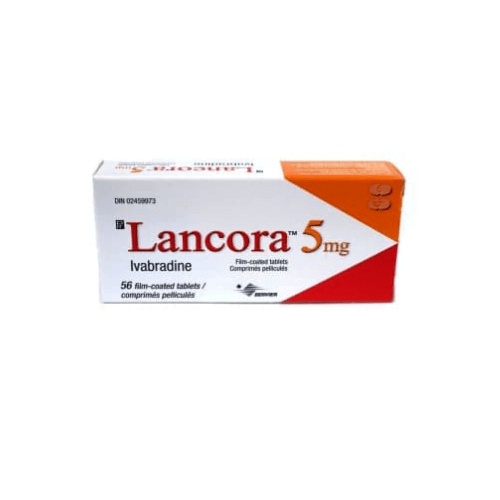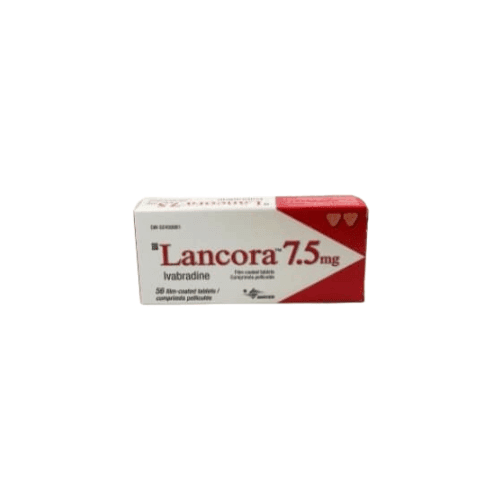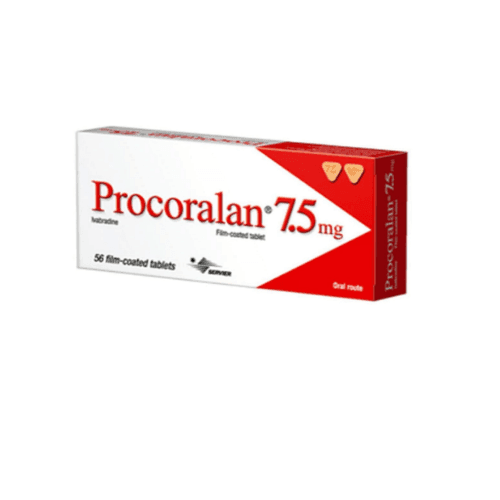Shipping with this method takes 3-5 days
Lancora® Tablets for Chronic Heart Failure
Stock up and Save - Get 20% off when you buy 3 or more of any one product. Use code SAVE20 at checkout.
Coupon code cannot be combined with other offers. Sale applies to all products originating from Canada. Maximum allowable quantity equal to a 90 day supply per single order.
Price range: $65.99 through $118.99
Secure Encrypted Payments
This prescription medicine helps some adults with chronic heart failure or stable angina. It works by slowing the heart’s natural pacemaker to reduce workload. With US delivery from Canada, it may help you manage expenses, including ivabradine without insurance.
What Lancora® Is and How It Works
This medicine contains ivabradine, a heart rate–lowering therapy. It selectively inhibits the If current within the sinoatrial node. That action reduces resting and exercise heart rate without directly affecting blood pressure or myocardial contractility. In appropriate patients, slowing heart rate can help reduce symptoms and the risk of hospital visits for worsening heart failure when added to guideline-directed therapy.
YouDrugstore is a licensed Canadian pharmacy in Manitoba. Pharmacists review prescriptions before dispensing.
In Canada, ivabradine may also be used to relieve symptoms of chronic stable angina in adults who are in normal sinus rhythm. It is not a substitute for emergency care. Always follow your prescriber’s instructions and the official product monograph.
Who It’s For
Ivabradine tablets are used in adults with stable, symptomatic chronic heart failure with reduced ejection fraction who are in sinus rhythm with an elevated resting heart rate. Clinicians often add it when beta-blockers are not tolerated or when heart rate remains high despite standard therapy. In some regions, it may be considered for adults with chronic stable angina who cannot take, or need more than, first-line options.
People who should not take this treatment include those with acute decompensated heart failure, significant bradycardia, sick sinus syndrome, sinoatrial block, or third-degree AV block unless a functioning pacemaker is present. Pacemaker-dependent patients, those with very low blood pressure, and people with severe liver impairment should avoid it. Discuss your specific history, including conduction disorders and visual disturbances, with a healthcare professional. For general condition education, see Heart Failure.
Dosage and Usage
Typical adult regimens start with a twice-daily schedule taken with meals. The dose may be adjusted based on resting heart rate, overall response, and tolerability. Some people, such as older adults or those with conduction issues, may start lower as directed by the prescriber. Do not change your dose or stop therapy unless your clinician asks you to.
Administration tips:
- Take doses about 12 hours apart with food.
- Avoid grapefruit or grapefruit juice, which can affect blood levels.
- Report resting heart rate checks to your prescriber as advised.
- Tell your care team if you notice new dizziness, fatigue, or visual brightness episodes.
If you are unsure about your specific schedule, follow the official label and your prescriber’s guidance.
Strengths and Forms
Film‑coated oral tablets are supplied in these commonly available strengths:
- Lancora 5 mg tablets
- 7.5 mg tablets
Availability can vary by manufacturer and lot. Tablet shape and color may differ by strength and supplier.
Missed Dose and Timing
If you miss a dose, take the next one at the regular time. Do not double up to make up for a missed dose. Keep a simple routine, such as morning and evening with meals, to help maintain consistency. If you miss doses frequently, speak with your clinician about strategies to support adherence.
Storage and Travel Basics
Store tablets at room temperature in a dry place, away from moisture and direct light. Keep them in the original packaging until use, out of reach of children and pets. Do not use tablets that are damaged or expired.
For travel, carry your prescription in its original labeled container. Pack enough for the entire trip plus a small buffer. Keep a copy of your prescription or a medication list. If crossing time zones, keep the interval between doses consistent rather than anchoring to the clock time at home. Ask your prescriber or pharmacist if you need help adjusting the schedule.
Benefits
This therapy reduces heart rate by a targeted mechanism, which can lower the workload on the heart. When used in appropriate adults with heart failure and sinus rhythm, it may reduce the likelihood of hospital admission for worsening symptoms. For select angina patients, heart rate control can help reduce the frequency of attacks and improve exercise tolerance. Many people appreciate that it targets rate without the blood pressure effects typical of some other options.
Side Effects and Safety
- Bradycardia or slow pulse
- Fatigue or dizziness
- Blurred vision or luminous phenomena (brief light flashes)
- Headache
- High blood pressure readings
- Nausea
Serious effects are less common but can include atrial fibrillation, conduction block, and symptomatic hypotension. Visual brightness episodes often appear early and may lessen with time. Seek urgent care for fainting, severe dizziness, irregular heartbeat, or sudden vision changes. This medicine is not recommended during pregnancy; discuss plans with your prescriber and review appropriate contraception if applicable.
Drug Interactions and Cautions
Strong CYP3A4 inhibitors can markedly raise ivabradine exposure and are generally contraindicated. Examples include ketoconazole, clarithromycin, certain HIV protease inhibitors, and some azole antifungals. Potent inducers, such as rifampin or St. John’s wort, may lower levels and reduce effect. Combining with non‑dihydropyridine calcium channel blockers like verapamil or diltiazem can also increase exposure and slow heart rate further.
Use caution with other heart rate–lowering therapies, including beta‑blockers, digoxin, or certain antiarrhythmics. Avoid grapefruit products. For more on interaction principles, explore Top Interactions and background on anticoagulants in Warfarin Uses. Always share a full medication list with your healthcare professional.
What to Expect Over Time
Heart rate typically decreases soon after starting, but symptom changes can vary. Your clinician may monitor pulse, blood pressure, and symptoms and adjust therapy when appropriate. Visual brightness side effects, if they occur, are usually brief and often triggered by sudden light changes. Keep regular follow‑ups, take doses with meals, and maintain consistent timing. Report any palpitations or episodes of dizziness promptly.
Compare With Alternatives
Prescribers often use a combination of treatments for heart failure. An angiotensin receptor–neprilysin inhibitor such as Entresto® may be part of a core regimen for many adults with reduced ejection fraction. For rate control or angina in other contexts, a beta‑blocker such as Lupin Propranolol La might be considered. These medicines work differently and are not interchangeable. Your prescriber will choose based on your diagnosis and overall plan.
Pricing and Access
See current options, compare the Lancora price, and review supply details before placing an order. We list clear information so you can plan refills with confidence. Because we offer Canadian pricing with US shipping from Canada, many people find it a practical way to manage ongoing therapy costs. For those comparing products, you can also review the ivabradine price alongside the branded option.
Checkout uses encrypted checkout to help protect your information. If you are looking for seasonal deals, visit our Promotions page for current offers.
Availability and Substitutions
Stock can vary. If this item is temporarily unavailable, your prescriber may recommend a different strength or an alternative therapy from the same class or another class. Pharmacists can coordinate with your clinician when a substitution is clinically appropriate. You can also browse related items under Other if advised by your prescriber.
Patient Suitability and Cost-Saving Tips
This treatment may suit adults in sinus rhythm with heart failure and elevated resting heart rates who need additional rate control. It may not be suitable for those with conduction disease, very low pulse, pacemaker dependence, or severe liver impairment. Share all medical history, including pregnancy plans and eye conditions, with your clinician.
Cost tips:
- Opt for multi‑month fills when your prescriber approves.
- Schedule refills a little early to avoid gaps.
- Use reminders on your phone for dose timing.
- Review alternatives if your regimen changes.
Questions to Ask Your Clinician
- Is ivabradine appropriate for my type of heart failure or angina?
- What resting heart rate target should I aim for?
- Which other medicines should I continue alongside this therapy?
- How will we monitor for bradycardia or atrial fibrillation?
- What should I do if I notice visual brightness episodes?
- Are there lifestyle changes that could support my treatment plan?
Authoritative Sources
Health Canada Drug Product DatabaseFDA Prescribing Information (Ivabradine)DailyMed Official Labeling
Ready to proceed? Place your prescription and we’ll handle the rest with express shipping, with temperature-controlled handling when required. Prescription required. This information is not a substitute for professional medical advice; always follow your prescriber and the official label.
Express Shipping - from $25.00
Prices:
- Dry-Packed Products $25.00
- Cold-Packed Products $35.00
Shipping Countries:
- United States (all contiguous states**)
- Worldwide (excludes some countries***)
Standard Shipping - $15.00
Shipping with this method takes 5-10 days
Prices:
- Dry-Packed Products $15.00
- Not available for Cold-Packed products
Shipping Countries:
- United States (all contiguous states**)
- Worldwide (excludes some countries***)
How does this medicine lower heart rate without lowering blood pressure much?
Ivabradine works on the heart’s natural pacemaker by selectively inhibiting the If current in the sinoatrial node. This slows the firing rate and reduces the heart rate at rest and during exercise. Because its action is specific to this pacemaker current, it has minimal direct effect on cardiac contractility or blood vessel tone. That is why it typically has limited impact on blood pressure compared with some other options. Your individual response can vary, so regular monitoring is important.
Can it be used together with beta‑blockers?
Yes, clinicians often combine ivabradine with a beta‑blocker when heart rate remains elevated despite guideline‑directed therapy for heart failure and the rhythm is sinus. The dose is based on heart rate and tolerability. Some beta‑blockers and non‑dihydropyridine calcium channel blockers can interact through CYP3A4 or additive heart rate effects, so your prescriber will consider combinations carefully. Do not start, stop, or change any medicines without consulting your healthcare professional.
What visual side effects should I watch for?
Some people notice transient luminous phenomena, often described as brief flashes or increased brightness, especially with sudden changes in lighting. These episodes are usually mild and may lessen over time. Blurred vision or new visual symptoms should be reported. If visual changes are persistent, severe, or interfere with daily activities, contact your clinician. Reading the official label can help you understand how often these events occur and what to do if they happen.
Is it safe during pregnancy or breastfeeding?
Ivabradine is generally not recommended during pregnancy due to potential risks to the developing baby. People who could become pregnant should discuss reliable contraception before starting therapy. Data during breastfeeding are limited, and transfer into human milk is uncertain. Your clinician will weigh benefits and risks and may recommend alternative options. Always consult your healthcare professional for individualized advice before conceiving, during pregnancy, or while nursing.
What happens if my resting pulse gets too low?
A low resting heart rate may cause dizziness, fatigue, or fainting. Contact your prescriber if you experience symptoms suggesting excessive bradycardia. Your care team may reassess your medicines, check for interactions, and review heart rhythm. Do not change your dose on your own. Seek urgent help for severe dizziness, fainting, or palpitations. Monitoring heart rate at home, as advised by your clinician, can help detect issues early.
Are there foods or supplements I should avoid?
Avoid grapefruit or grapefruit juice, which can increase ivabradine levels. St. John’s wort can lower levels and reduce effectiveness. Be cautious with other heart rate–lowering products or stimulants. Share all supplements, over‑the‑counter medicines, and herbal products with your healthcare professional so they can evaluate possible interactions. A balanced diet and consistent salt intake recommended by your clinician can also support overall heart health.
How long does it take to notice changes?
Heart rate reduction can occur soon after doses begin, but symptom changes vary by person and condition. Your clinician may check your pulse and symptoms during the first weeks and adjust therapy if needed. Visual brightness events, if they appear, are often early and may fade with time. Keep taking your doses with meals and keep scheduled follow‑ups. Never stop therapy suddenly without medical advice.


